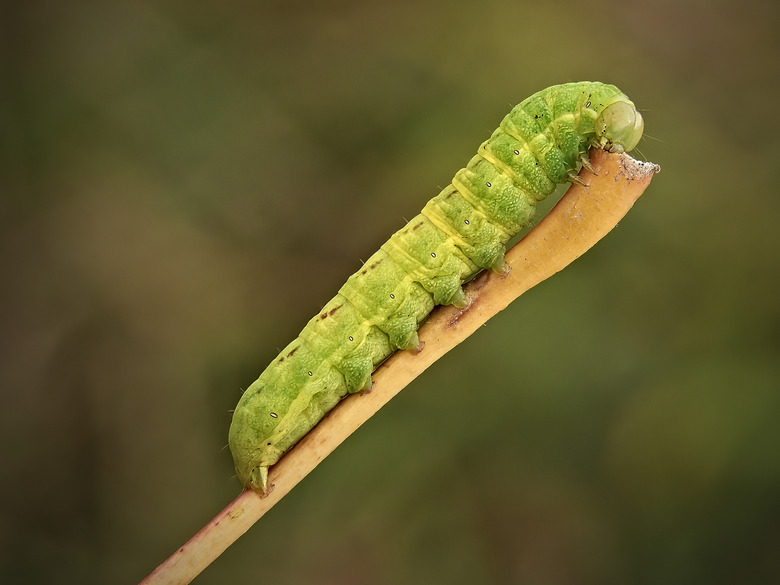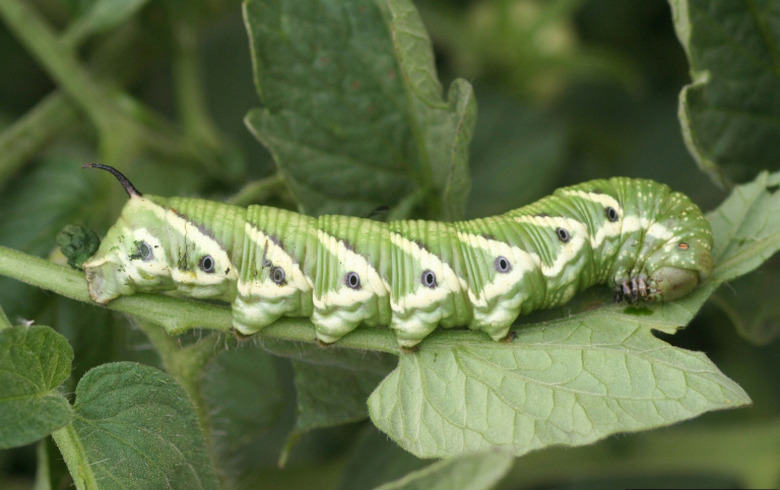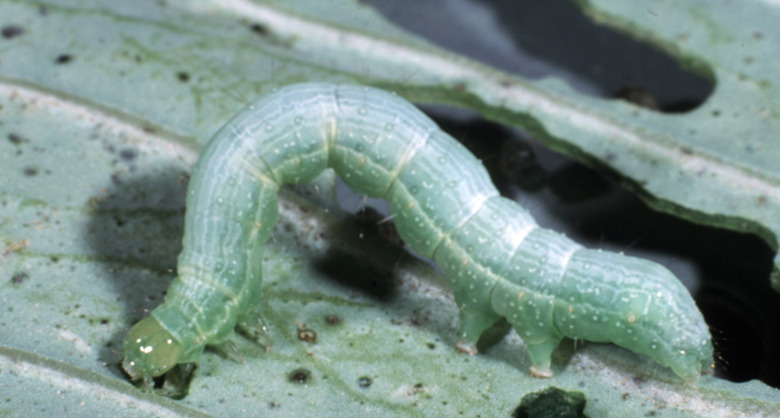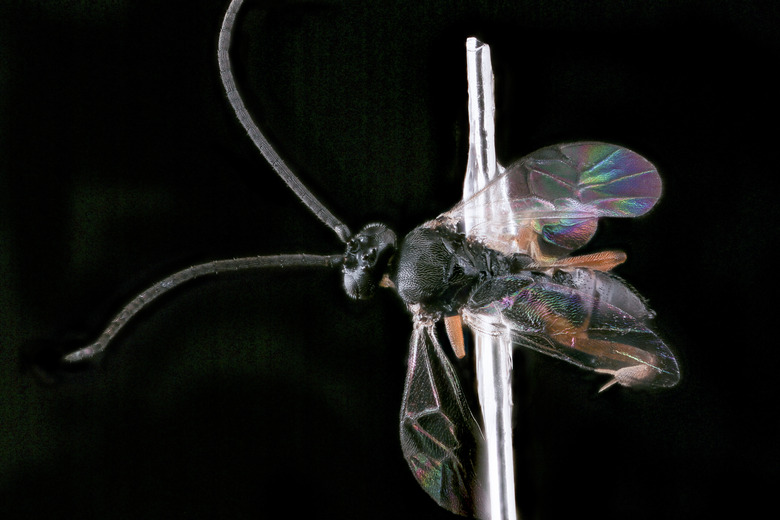How To Kill Green Worms In A Garden
Stripped stems, skeletal leaves and damaged produce are all signs that something is amiss in the garden. When careful examination of the foliage reveals green worms eating the plants, take action to protect the leaves, fruits, vegetables and flowers before the voracious creatures chew the plants down to nubs.
Eco-friendly methods include natural pesticides, predatory insects, hand-picking and using cultural controls to eliminate the big or little green caterpillars eating the plants.
Identifying the Green Worm Species
While removing or killing the green worms is important for the survival of the garden plants, it is equally important to identify the species to ensure that the best removal method is employed. Natural pesticides are one option, but they don't work on every type of green worm.
Green worms, or caterpillars, can be identified by their size or markings and sometimes by the type of plant they're devouring.
Big, Fat Green Worms: Tomato Hornworms and Green Cutworms
**Tomato hornworms:** The fat green worms sporting diagonal white stripes and a vicious-looking red or black spike are tomato hornworms (Manduca quinquemaculata). These fat worms are caterpillars of the lovely hawk moth, which features wingspans of up to 5 inches and is sometimes mistaken for a hummingbird.
While the up to 4-inch-long hornworms are completely harmless to humans, they devour the leaves and fruits of the tasty tomatoes (Solanum lycopersicum, USDA zones 10 to 11), grown as annuals in most North American gardens. They also feast on the foliage of other plants in the Solanaceae family, such as eggplant (Solanum melongena, USDA zones 9 to 12), peppers (Capsicum spp., USDA zones 9 to 11) and potatoes (Solanum tuberosum).
**Green cutworms:** When digging in the garden, 1- to 2-inch-long green worms may be found in the soil. The chubby green cutworm (order Lepidoptera) chews on the stems of new seedlings, decimating the garden before the plants have a chance to grow.
There are three general types: surface, climbing and subterranean, which may be almost white, light green, brown, gray or black in solid colors or with stripes or spots depending on the species. Like the hornworm, cutworms are moth caterpillars.
Little Green Worms: Loopers, Earworms, Inchworms and Sawflies
**Cabbage loopers and cabbage worms:** Little green worms found devouring vegetable leaves and inside ears of corn may be the caterpillars of one of several moth or butterfly species. Cabbage loopers (Trichoplusia ni) and imported cabbage worms (Pieris rapae) are widespread in North America, feeding on cole crops like cabbage and broccoli, while other looper species target lettuce, spinach, soybeans and other greens.
**Corn earworms:** Yellow-green or brown with pale stripes and black spots, corn earworms (Helicoverpa zea) are found inside ears of ripening corn as well as decimating other vegetables and ornamental plants in the garden.
**Oak leafrollers and oak leaftiers:** In spring, little green worms may be seen hanging from oaks (Quercus spp., USDA zones 3 to 10) and other nut-bearing trees. Often called "inchworms," the 1/4- to 1-inch-long oak leafroller (Archips semiferanus) and oak leaftier (Croesia semipurpurana) caterpillars thrive on the new leaves and flowers emerging on the trees. The adult moths are only 1/2 inch wide, tan and brown or yellow and brown, respectively.
**Sawflies:** Other little green worms that enjoy the foliage of shrubs and trees include the various species of sawfly (order Hymenoptera), such as the rose sawfly (Endelomyia aethiops), commonly known as roseslug; pear sawfly or pearslug (Caliroa cerasi); and azalea sawflies (Amauronematus azalea and Nematus lipvskyi). The 3/4- to 1-inch-long larvae of these fly-like relatives of bees and wasps have a greenish slime covering their body, leading to the "slug" common names. They eat every bit of the leaves except the veins, leaving only a skeletonized leaf.
Warning
Spinosad is highly toxic to honeybees and native bees, moderately toxic to earthworms and slightly toxic to birds. Its effect on fish and other aquatic creatures varies; avoid applying it near wetlands and waterways.
Finding Eco-Friendly Control Solutions for Green Worms
While there are an assortment of pesticides available for use in the garden, there are more eco-friendly ways to control infestations of green worms.
Applying natural pesticides, releasing predatory wasps, hand-picking and practicing cultural controls are relatively safe and effective ways to kill the green worms without endangering beneficial insects, birds, fish, pets and humans.
The Natural Pesticides: BtK and Spinosad
**BtK:** The safest insecticide or pesticide to use on moth and butterfly caterpillars is Bacillus thuringiensis Kurstaki (BtK). A natural soil bacterium, BtK affects the digestive system of caterpillars so they stop feeding and die.
It is best used while the caterpillars are still small and voraciously eating the plants, but it is not effective on sawfly larvae. BtK is safe to use in the garden and has a low toxicity to humans, pets, bees and other beneficial insects, birds and fish, though it should not be applied to standing water, such as ponds and birdbaths.
**Spinosad:** Spinosad is a combination of two chemicals, spinosyn A and spinosyn D, obtained from natural soil bacteria. It affects the nervous system of sawfly larvae as well as other insects that ingest or touch it. Spinosad is highly toxic to honeybees and native bees, moderately toxic to earthworms and slightly toxic to birds. Its effect on fish and other aquatic creatures varies; avoid applying it near wetlands and waterways.
Put on protective gear, including gloves, safety goggles and a mask, before mixing and applying BtK and spinosad products to avoid exposure to the bacteria. Always follow the package directions when applying any pesticide in the garden. Gardeners should avoid using any pesticides on plants that are hosting caterpillars of desirable butterflies, like the monarch and swallowtail species.
Nature's Predators: Wasps and More
Encourage predators, such as braconid wasps (Cotesia congregates), to the garden by planting flowers that attract these beneficial insects. They lay their eggs on tomato hornworms; if there are protruding white cocoons on the green worm's skin, leave them alone. The wasp larvae feed on the hornworm, and it will die as the adult wasps leave their cocoons and repeat their life cycle.
Other predators include birds, lacewing larvae (family Chrysopidae), assassin bugs (family Reduviidae) and minute pirate bugs (family Anthocoridae). The larvae of various species of ladybugs (family Coccinellidae), known predators of aphids, also feast on the eggs of beetles and small caterpillars that infest the garden.
Prevention: Tips and Tricks
- Preventing caterpillar infestations begins in fall. If caterpillars have been an issue, clean the garden and landscape, removing fallen fruits, plant debris and weeds that host the little green pests.
- Till the soil to disrupt the caterpillars' life cycle and provide a feast of eggs and/or cocoons for the birds.
- Also rotate the garden bed so cole and tomato plants are in a different location every year.
- When spring arrives, use cardboard collars around new seedlings to prevent cutworm damage. As spring warms into summer, monitor plants for signs of eggs and green worms.
- Use blasts of water to knock caterpillars off the plants' leaves.
- Hand-pick larger caterpillars, like tomato hornworms, by following the line of leaf stubs on the stem until the caterpillar becomes visible. Gloves are not necessary; pluck the caterpillar from the stem and drop it into a bucket of soapy water.
- Sticky collars placed around the trunks of shrubs and trees can help keep the green worms that hatched in the soil from climbing up and feeding on the foliage. If holes appear in the leaves, check the plant and hand-pick the caterpillars or remove the infested branch and leaves and then place them in a plastic bag inside a garbage can.
References
- Wisconsin Horticulture Division of Extension: Hornworms
- Missouri Botanical Garden: Lycopersicon esculentum
- UC Master Gardeners of Butte County: Cutworms – Unwelcome Visitors to the Garden
- NC Cooperative Extension: Controlling Caterpillars in Vegetable Gardens
- South Dakota State University Extension: Imported Cabbage Worms Are Chewing up My Garden!
- UCCE Master Gardeners of Orange County: Edible Plants
- NC State Extension: Corn Earworm on Ornamentals
- Missouri Botanical Garden: Rose and Pear Slugs (Sawflies)
- Missouri Botanical Garden: Bacillus thuringiensis (Bt) Kurstaki and Israelensis Strains
- National Pesticide Information Center: Spinosad
- UC IPM: Natural Enemies of Caterpillars



